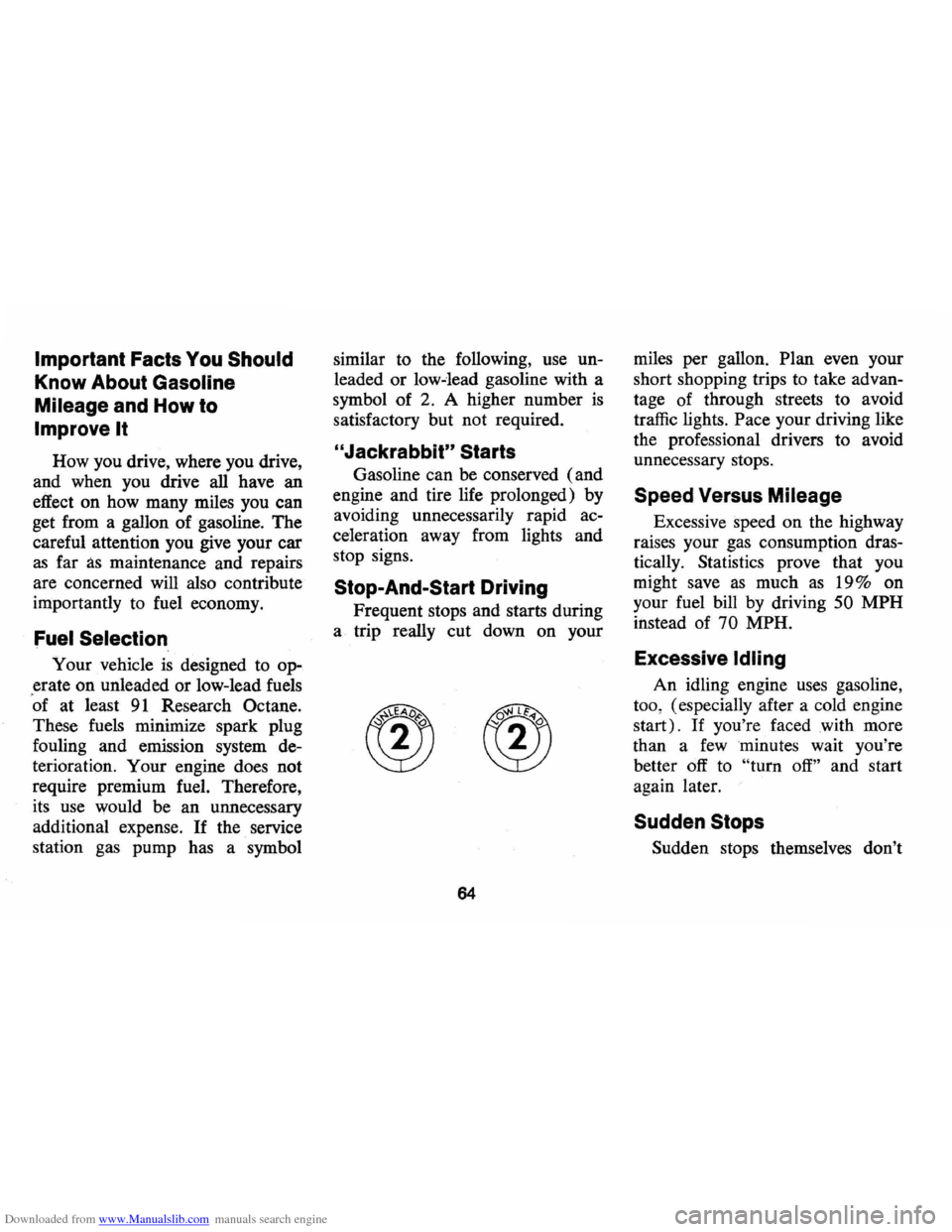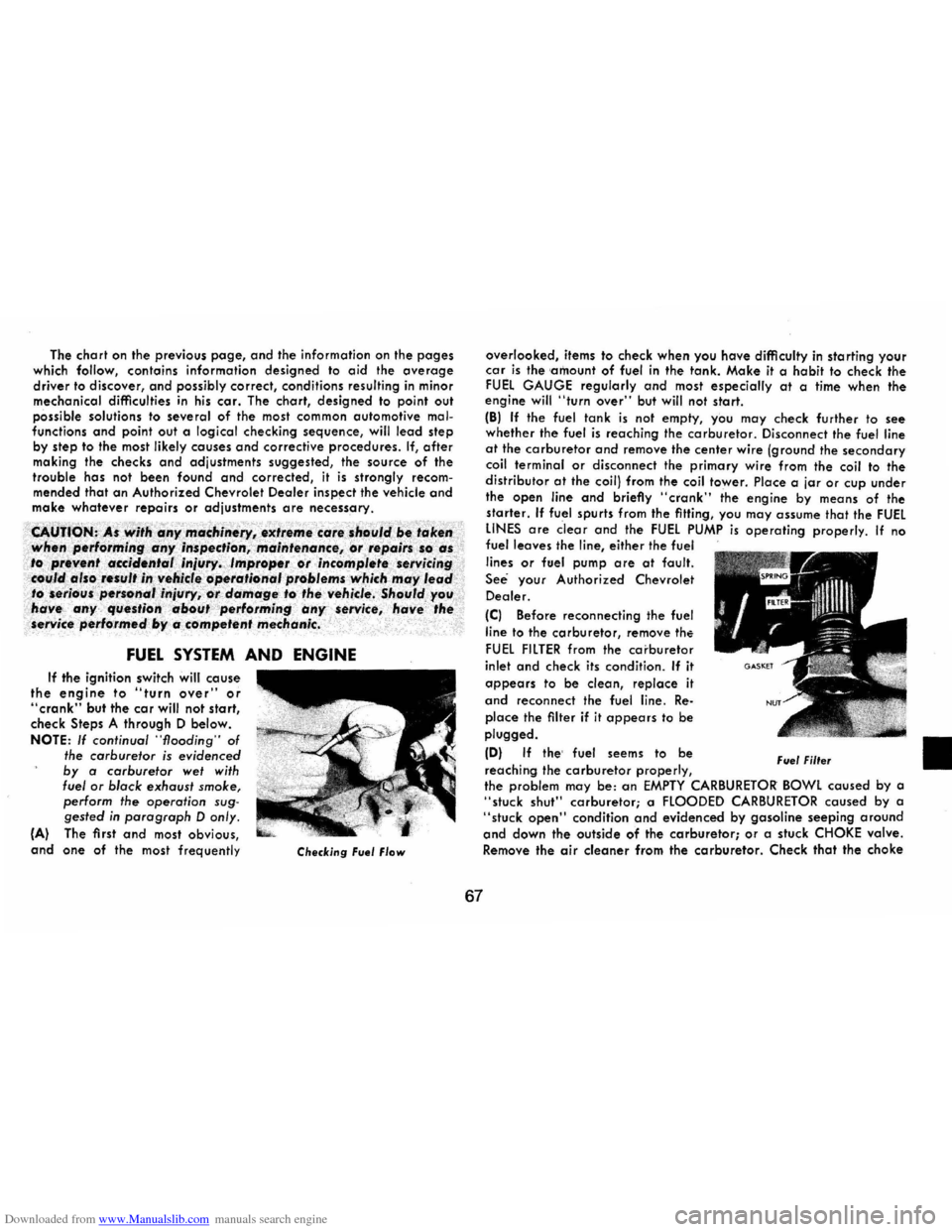1974 CHEVROLET CAMARO fuel pump
[x] Cancel search: fuel pumpPage 19 of 85

Downloaded from www.Manualslib.com manuals search engine proper gear position before re
leasing the clutch pedal.)
3.
Operate accelerator pedal and
starter
as outlined in step 3
(under Automatic Transmission
Models).
Engine Flooded
Depress accelerator pedal and
hold to floor while starting until
engine
is cleared of excess fuel and
is
running smoothly. Never
"pump" the accelerator pedal.
Warm-Up
Always let the engine idle for 20
to 30 seconds after starting and
drive at moderate speeds for several
miles, especially during cold
weather.
Driving with the Chevrolet Automatic Transmissions
The Turbo Hydra-Matic 350
and 400 are completely automatic
transmISSIons. All replace the
standard clutch and transmission.
Turbo Hydra-Malic 350
and 400
After starting the engine with the
selector lever
in N (Neutral) or P
(Park)
position select the range de
sired (see table) and depress the accelerator.
A gradual start with a
steady increase in accelerator pres
sure will result in best possible fuel
economy. Rapid acceleration for
fast starts will result in greater
fuel consumption.
Automatic transmission shift
quadrants of all GM cars continue
the uniform sequence of selector
positions. This particularly benefits
multicar families and those who
occasionally drive other cars. Shift
16
indicators are arranged with "Park"
position at one end, followed in se
quence by "Reverse" , "Neutral"
and the forward driving ranges.
All automatic transmissions are
equipped with a starter safety
switch designed to permit starting
the engine only when the trans
mission
is in the "Park" or "Neu
tral"
position. For additional
engine braking effect,
as sometimes
needed in mountainous driving,
Page 49 of 85

Downloaded from www.Manualslib.com manuals search engine SERVICE AND MAINTENANCE
The time or mileage intervals on
the following pages are intended
as
a guide for establishing regular
maintenance and lubrication
periods for your car. Sustained
heavy duty or high speed operations
or operation under adverse condi
tions may necessitate more frequent
servicing. To determine specific
recommendations for conditions
under which you use your car, con-
Fuel
Requirements
. Your Camaro is designed to op
erate on unleaded
or low lead fuels
of at least
91 Research Octane.
These fuels will minimize spark
plug fouling and emission control suIt
your Authorized Chevrolet
Dealer.
Maintenance Schedule
For owner convenience, a sep
arate maintenance folder has been
provided with your car which con
tains a complete schedule and
brief explanation of the safety,
emission control, lubrication and
system
deterioration. Fuels with
Regular grade octane quality
should be used only when needed
to eliminate
knock-a metallic rap
ping noise generated during the
combustion process. The engine
does not require
Premium fuel.
Therefore, its use would be an un
necessary additional expense.
If
knocking persists, consult your
46
general maintenance it requires.
The maintenance folder informa
tion
is supplemented by this sec
tion of the
Owner's Manual, as
well as the separate emission con
trol systems folder also furnished
with your car. Read all three pub
lications for a full understanding
of vehicle maintenance require
ments.
authorized Chevrolet dealer.
In
any case, continuous or excessive
knocking may result in engine
damage and constitutes misuse of
the engine for which Chevrolet
Motor Division
is not responsible
under the terms of the New Vehicle
Warranty.
If the service station gas pump
has a symbol similar to the samples
Page 67 of 85

Downloaded from www.Manualslib.com manuals search engine Important Facts You Should
Know About Gasoline
Mileage and How to
Improve It
How you drive, where you drive,
and when you drive
all have an
effect on how many miles you can
get from a gallon of gasoline. The
careful attention you give your car
as far as maintenance and repairs
are concerned will also contribute
importantly to fuel economy.
Fuel Selection
Your vehicle is designed to op
erate on unleaded or low-lead fuels
>of at least 91 Research Octane.
These fuels minimize spark plug
fouling and emission system
de
terioration. Your engine does not
require premium fuel. Therefore,
its use would be an unnecessary
additional expense.
If the service
station gas pump has a symbol similar
to the following, use
un
leaded or low-lead gasoline with a
symbol of 2. A higher number
is
satisfactory but not required.
"Jackrabbit" Starts
Gasoline can be conserved (and
engine and tire life prolonged) by
avoiding unnecessarily rapid
ac
celeration away from lights and
stop signs.
Stop-And-Start Driving
Frequent stops and starts during
a. trip really cut down on your
64
miles per gallon. Plan even your
short shopping trips to take
advan
tage of through streets to avoid
traffic lights.
Pace your driving like
the professional drivers to avoid
unnecessary stops.
Speed Versus Mileage
Excessive speed on the highway
raises your gas consumption
dras
tically. Statistics prove that you
might save
as much as 19% on
your fuel bill by driving
50 MPH
instead of 70 MPH.
Excessive Idling
An idling engine uses gasoline,
too, (especially after a cold engine
start).
If you're faced with more
than a
few minutes wait you're
better
off to "turn off" and start
again later.
Sudden Stops
Sudden stops themselves don't
Page 70 of 85

Downloaded from www.Manualslib.com manuals search engine The chart on the previous page, and the information on the pages which follow, contains information designed to aid the average driver to discover, and possibly correct, conditions resulting in minor
mechanical difficulties in his car. The chart, designed to point out
possible solutions to several of the most common automotive malfunctions and point out a logical checking sequence, will lead step by step to the most likely causes and corrective procedures. If, after making the checks and adjustments suggested, the source of the trouble has not been found and corrected, it is strongly recom
mended that an Authorized Chevrolet Dealer insp~ct the vehicle and make whatever repairs or adjustments are necessary.
;iA~>~I/~,~.#Y'T~~hiri~~:e~It.;ne;CC2i'~6p'4~cl~.;.'Ii~;~;,;(i '~i.. . .....•.. l'for",;tlgC;(lnY;tlspec';o~;1J1 ainfenCJn.c:~ ..
If the ignition switch will cause the engine to "turn over" or "crank" but the car will not start, check Steps A through 0 below. NOTE : If continual "flooding" of the carburetor is evidenced by a carburetor wet with
fuel or black exhaust smoke,
perform the operation sug
gested in paragraph D only .
(A) The first and most obvious, and one of the most frequently Checking Fuel Flow
67
overlooked, items to check when you have difficulty in starting your car is the 'amount of fuel in the tank. Make it a habit to check the FUEL GAUGE regularly and most especially at a time when the engine will "turn over" but will not start.
(B) If the fuel tank is not empty, you may check further to see whether the fuel is reaching the carburetor. Disconnect the fuel line at the carburetor and remove the center wire (ground the secondary coil terminal or disconnect the primary wire from the coil to the
distributor at the coil) from the coil tower. Place a jar or cup under the open line and briefly "crank" the engine by means of the starter. If fuel spurts from the fitting, you may assume that the FUEL LINES are clear and the FUEL PUMP is operating properly. If no fuel leaves the line, either the fuel
lines or fuel pump are at fault ,
See your Authorized Chevrolet
Dealer.
(C) Before reconnecting the fuel
line
to the carburetor, remove the
FUEL FILTER from the carbu retor
inlet and check its condition . If it
appears to be clean, replace it
and reconnect the fuel line. Re
place the filter if it appears to be plugged.
(0) If the' fuel seems to be
reaching the carburetor properly, Fuel Filter
the problem may be: an EMPTY CARBURETOR BOWL caused by a "stuck shut" carburetor; a FLOODED CARBURETOR caused by a "stuck open" condition and evidenced by gasoline seeping around and down the outside of the carburetor; or a stuck CHOKE valve. Remove the air cleaner from the carburetor. Check that the choke
•